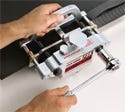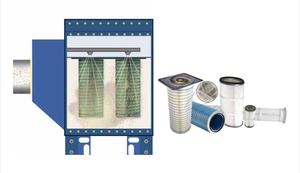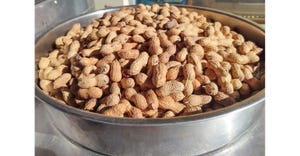September 26, 2008
By Kevin Finnegan
|
FSK skiver |
Belt skivers remove a conveyor belt’s cover to prepare a belt for countersunk fasteners. A skiver is specially designed to help ensure quick, safe, and accurate cover removal at various depths. It eliminates imprecise and potentially dangerous cuts that can result from hand-knife skiving. It is also a cleaner and faster alternative to a router, since the skiver removes the top cover as one continuous strip, and does so in minutes. This makes skivers an invaluable tool for the belt-repair process.
Mechanical conveyor-belt splicing, which usually includes hinged- or solid-plate fasteners (clips) attached to the belt with bolts or rivets, is widely used in heavy-duty operations because of its relatively low cost and ease and speed of installation. However, abrasiveness and density can vary wildly, increasing the potential for premature splice wear and failure.
There are many reasons why it is important to skive a belt prior to fastener installation. In most cases, skiving will save both time and money throughout the production process, and it does not weaken a conveyor belt. All of the strength is found in the carcass; the cover is in place simply to protect it. When someone skives a belt, he or she replaces this protective rubber with the belt fasteners that will protect the belt and keep it moving to maximize production. The user does not want to remove all of the cover—he or she should leave 1⁄16 in. in place to provide protection from the elements: water, sun, etc.
The major benefits of skiving a belt include:
Achieving a lower profile. Since skiving a belt removes the belt’s top layer, it leaves room for the fasteners to lie evenly with or below the rest of the belt surface. This reduces the chance of the fasteners catching themselves on any belt components or on the conveyor structure itself.
Longer splice life. A properly skived belt will last much longer because you are achieving a lower profile, preventing excess wear and tear on the fasteners.
Compatibility with cleaners. When a belt is skived, cleaners and other conveyor components are able to work on a relatively smooth surface in which the belt fasteners and cleaners work effectively together. Not only does this create a compatible surface for cleaners, it also increases cleaner-blade and fastener life. Manufacturers that produce both fasteners and cleaners are often in the advantageous position to advise on the interfacing between fasteners and cleaners.
Better wear of fasteners when used with skirting. Similarly, a skived belt also reduces the wear and tear to which the skirting and fasteners are subjected, resulting in prolonged operation and reduced maintenance. By placing the top of the fasteners beneath the lower edge of the skirt rubber, the user eliminates excessive wear on either item.
Stronger splices. When a belt is skived, it removes the top rubber layer from the belt, placing the top and bottom plates of each fastener closer together, ensuring that the teeth are properly engaged into the carcass. This results in improved strength of the belt splice.
For all of the above reasons, skiving is highly recommended when splicing a belt. However, there are some reasons why skiving might not be chosen, including:
Top cover is worn. When the top cover is very thin or worn, skiving is not recommended.
Fastener size. Belt thickness is but one of several factors used to determine fastener size. In cases where the wrong fastener size is used, skiving the belt would adversely affect the fasteners.
Time pressure. Sometimes in a time crunch, proper skiving of a belt is overlooked in an attempt to minimize downtime. Generally speaking, this is counter-productive. Although this does save time initially, in the long run it will result in additional downtime.
Choosing the Right Tool
Traditional skiving tools typically employ a wide cutting head drawn across the belt by a manual winch and guided by a lightweight aluminum track. A stirrup-shaped blade, mounted in the cutting head, adjusts in 2-mm increments to a maximum depth of 14 mm. Adjustment allows the blade to remove the desired amount of belt-top cover cleanly, smoothly, and uniformly in one pass. This leaves a flat-bottom trough with rounded lower corners to prevent the adjacent belt-cover material from tearing along the bottom edge.
With some skivers, the cutting head also features a cutoff blade that adjusts vertically for belts up to 35-mm thick. A second pass of the head with this blade extended makes a clean, square, and straight cut along the bottom of the skived area, establishing a finished belt end by trimming the trough for the selected fastener size.
Newer, compact belt skivers eliminate the guide track and winch, as well as the need to nail down the belt, while enabling fast, easy removal of conveyor-belt cover material. Employing an integral ratchet-driven roller design, these hand-operated tools carve a flat-bottomed trough as deep as 10 mm in a single pass. The multiple-pass capability of these skivers allows for deeper skiving in rubber and synthetic belts up to 32-mm thick. A range of user-selected widths accommodates varying belt-fastener sizes.
Operation and Care
Operation begins with simple manual adjustments for desired skive depth and width. With the skiver properly positioned and secured on the belt end, users ratchet the tool across the width of the belt with one hand while guiding the tool with the other. Two pairs of rollers—each featuring a serrated upper and smooth lower roller—lamp the belt as the serrated rollers grip the top cover and drive the skiver, pulling a special steel blade through the belting. The skived belt cover comes off in one continuous strip. Easy hand-screw adjustment of roller tension allows optimum operation, preventing water and dirt from affecting the drive. The resulting flat-bottomed trough features a rounded inside corner to prevent the belt cover from splitting.
For maximum ongoing performance, skivers should be cleaned after each use and kept in a clean, dry area. Although the tools are rugged and durable, care should be taken to avoid dropping or tossing them. Both the top and bottom edges of the blades should be examined, making sure they are sharp and undamaged. Some skiver designs enable the blade to be sharpened while it is attached to the tool.
Properly selected and used, skivers represent a sound investment. They provide precise and uniform cuts and eliminate the problems and injury potential associated with hand-knife use. In terms of both safety and conveyor productivity, skivers are tools that pay for themselves many times over.
Kevin Finnegan is a mechanical fastener application specialist with Flexco (Downers Grove, IL). For more information, visit www.flexco.com.
You May Also Like



